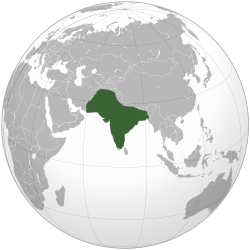Mughal Empire
Mughal Empire | |
|---|---|
| 1526–1857 | |
|
Banner | |
 The Mughal Empire durin the reign o Aurangzeb c. 1700 | |
| Caipital | Agra (1526–1571) Fatehpur Sikri (1571–1585) Lahore (1585–1598) Agra (1598–1648) Shahjahanabad (1648–1857) |
| Common leids | Persian (offeecial an court leid)[1] Chagatai Turkic (only initially) Urdu (later period) |
| Releegion | Islam (1526–1582) Din-e Ilahi (1582–1605) Islam (1605–1857) |
| Govrenment | Absolute monarchy, unitary state wi federal structure |
| Emperor[2] | |
• 1526–1530 | Babur Beg (first) |
• 1837–1857 | Bahadur Shah II (last) |
| Historical era | Early modren |
| 21 Aprile 1526 | |
| 10 Mey 1857 | |
| Aurie | |
| 1700 | 4,500,000 km2 (1,700,000 sq mi) |
| Population | |
• 1700 | 150000000 |
| Currency | Rupee |
| The day pairt o | |
The Mughal Empire (Persie: گورکانیان Gūrkāniyān;[6] Urdu: مغلیہ سلطنت, Moghly-e Soltanat),[7] or Mogul (also Moghul) Empire in tradeetional English uisage, wis an imperial pouer in the Indian subcontinent frae aboot 1526 tae 1857 (though it lingered for anether century). The Mughal emperors wur Muslims an direct descendants o baith Genghis Khan (through his son Chagatai Khan) an of Tamerlane. At the heicht o their pouer in the late 17t an early 18t centuries, they controlled maist o the subcontinent—extendin frae Bengal in the east tae Balochistan in the wast, Kashmir in the north tae the Kaveri basin in the sooth. Its population at that time haes been estimatit as atween 110 an 150 million, ower a territory o mair nor 3.2 million square kilometres (1.2 million square miles).[8]
References
[eedit | eedit soorce]- ↑ Conan, Michel (2007). Middle East Garden Traditions: Unity and Diversity : Questions, Methods and Resources in a Multicultural Perspective, Volume 31. Washington, D.C.: Dumbarton Oaks Research Library and Collection. p. 235. ISBN 978-0884023296.
- ↑ The title (Mirza) descends to all the sons of the family, without exception. In the Royal family it is placed after the name instead of before it, thus, Abbas Mirza and Hosfiein Mirza. Mirza is a civil title, and Khan is a military one. The title of Khan is creative, but not hereditary. pg 601 Monthly magazine and British register, Volume 34 Publisher Printed for Sir Richard Phillips, 1812 Original from Harvard University
- ↑ "The Muslim and Mogul Empires". Archived frae the original on 21 Julie 2012. Retrieved 2 Apryle 2013.
- ↑ "Mughal Empire". Retrieved 2 Apryle 2013.
- ↑ "Mughal Empire in India, 16th century". Retrieved 2 Apryle 2013.
- ↑ Zahir ud-Din Mohammad (10 September 2002). Thackston, Wheeler M. (ed.). The Baburnama: Memoirs of Babur, Prince and Emperor. New York: Modern Library. p. xlvi. ISBN 978-0375761379.
In India the dynasty always called itself Gurkani, after Temür's title Gurkân, the Persianized form of the Mongolian [kürägän] error: {{lang}}: text has italic markup (help), 'son-in-law,' a title he assumed after his marriage to a Genghisid princess.
- ↑ Balfour, E.G. (1976). Encyclopaedia Asiatica: Comprising Indian-subcontinent, Eastern and Southern Asia. New Delhi: Cosmo Publications. S. 460, S. 488, S. 897. ISBN 978-8170203254.
- ↑ Richards, John F. (18 Mairch 1993). Johnson, Gordon; Bayly, C. A. (eds.). The Mughal Empire. The New Cambridge history of India: 1.5. I. The Mughals and their Contemporaries. Cambridge: Cambridge University Press. pp. 1, 190. doi:10.2277/0521251192. ISBN 978-0521251198.
|access-date=requires|url=(help)
